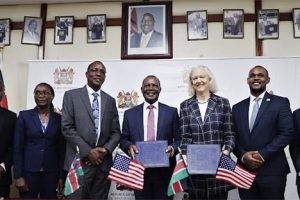
Impact of Cross-Border Conflicts on Trade in the East African Community
By Eunice Mutuku
The Escalating Tensions in East Africa
Over the past few years, East African countries have experienced increased cross-border conflicts that have significantly affected the region’s trade relations. For instance, the conflict between Kenya and Somalia over the ownership of Juba land has resulted in the closure of borders and loss of business. Likewise, the outstanding issues between Uganda and Rwanda, including the prolonged shutdown of the Gatuna border, have affected trade and dampened economic integration within the EAC region.
These conflicts, based on historical animosities, territorial claims, and political rivalry, have affected not only diplomatic ties but also the trading relations of the regions. Ongoing cross-border conflict in East Africa is a significant factor that hampers trade through interferences with the supply chain, increasing trade costs and creating an unfavorable business environment that scares away investors.
Harsh Reality of Country conflicts and related Disruptions
The economic consequences of these conflicts are complex. First, they cause damage to infrastructure such as roads, bridges, and trade centres that are critical in the movement of goods and services. For instance, the damage to the Nimule-Juba road and the resulting trade disruptions illustrate the broader economic consequences of cross-border conflicts in the EAC region. Further, conflicts lead to the closure of borders and increased security checks, which slow the transport of goods and increase transport costs and, consequently, the prices of goods.
Moreover, trade disruptions are not limited to the destruction of infrastructure. Disputes between countries usually result in the establishment of trade restrictions, including tariffs and non-tariff barriers, which hampers the exportation of commodities. For instance, the trade dispute between Tanzania and Kenya has seen the two countries put various obstacles to the flow of goods and services to the other’s market, thereby reducing the two nations’ trade. This volatility hampers economic planning and investment, leading to lower FDI and a slower rate of economic development.
“The cross-border conflicts in the East African community significantly and complexly influence trade.”
The East African Community (EAC) has one of its main objectives as the need for the promotion of economic cooperation in the region. Nevertheless, conflicts across borders constitute a significant challenge to realising this goal. This is a blow to EAC’s vision of a borderless market whereby commodities, services, and people can easily transverse the region due to the persistent conflicts. For instance, the daily cross-border disputes between the Kenyan and Ugandan communities over cattle theft and land issues affect the immediate economy and regional integration processes such as regional trade. These conflicts generate a state of instability that hampers the EAC’s ability to enforce its integration policies efficiently.
The consequences of cross-border conflicts cannot be limited to the humanitarian section. Situations of conflict lead to the displacement of people on a vast scale, which in turn leads to refugee problems that put enormous pressure on the countries hosting refugees. This displacement affects the local economies and trade relations. The refugee crisis in Uganda, where there is a large influx of refugees from South Sudan, has brought about both economic and social impacts that impact both countries’ ability to trade and maintain financial stability. Also, solving humanitarian problems consumes resources that could otherwise be helpful in facilitating trade for economic growth.
Inking on Better Cross-Border Relations
Despite these challenges, there are opportunities for resolution and improvement of cooperation in these processes. Negotiation and diplomacy are part of the process of the settlement of cross-border disputes and a significant precondition for the development of trade. One notable example within the East African Community (EAC) is the mediation effort between Kenya and Uganda over the disputed Migingo Island. In addition, the EAC and other regional bodies can actively participate in regulating conflicts and developing cooperation in the field of trade.

It is also necessary to intensify cooperation and communication at the regional level. This can be done by holding frequent forums and meetings where countries can sort out their issues and solve them peacefully. Secondly, investing in infrastructure capable of withstanding the impacts of conflict is vital. This entails diversification of trade routes and improving the capability of the ports and border structures to accommodate the growing trade flow. Lastly, encouraging the development of other sources of income can minimize the reliance on sensitive industries and develop a more robust and healthier economy that is less affected by war.
The cross-border conflicts in the East African community significantly and complexly influence trade. The impacts of infrastructure breakdown, disruption of supply, difficulties in economic integration in a particular region, and problems that affect humanitarianism are immense. However, with the efforts towards achieving peace and cooperation and adopting sound policies in the East African region, one can minimize these effects as the way to the area is paved for a better trade environment. Suppose the root causes of these conflicts are well dealt with, and the spirit of regional integration is enhanced, East Africa can overcome these challenges and realize its full economic potential.
These are writer’s own views and do not necessarily reflect the position and policy position of Liberty Sparks. For inquiries email us at [email protected]




2 Comments
good copy, educative too
Thank you